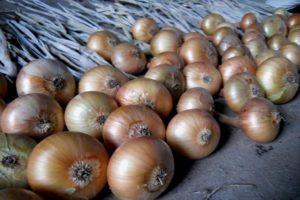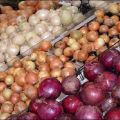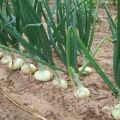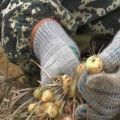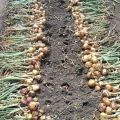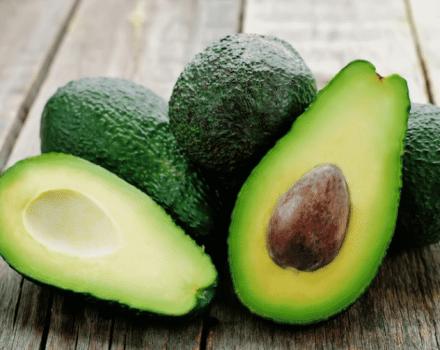Treatment of diseases of onions with folk remedies, recipes for combating them
Many gardeners are engaged in the cultivation of onions in their summer cottages. This vegetable is popular as it is often used to prepare various dishes. When growing onions, some are faced with serious diseases that prevent the plant from growing normally. Therefore, before planting a vegetable, you should familiarize yourself with onion diseases and their treatment.
The most common onion diseases
Frequent diseases are the main cause of poor vegetable yields. Onions also often suffer from diseases and are exposed to viral and bacterial diseases. They stop the growth of the vegetable and often lead to the death of the grown bushes. To get rid of onion diseases, you should properly fight them.
Peronosporosis onion or powdery mildew
Often onion bushes suffer from peronosporosis or powdery mildew, which is considered a rather dangerous disease. Every vegetable grower must know the peculiarities of the manifestation of the disease in order to start treating the plant in a timely manner. The disease is characterized by the following external signs:
- the appearance of white spots on the surface of the leaves;
- yellowing of the edges of the lower sheets;
- plaque on the sheets;
- gradual drying of the bushes.
This onion disease occurs due to an infection on the bulbs that gradually spreads to the rest of the bush. Infection appears if the gardener did not follow the rules of crop rotation or planted untreated seed.
Peronosporosis manifests itself in conditions of elevated temperature, when the air warms up to 20 degrees. At low temperatures, the disease progresses much more slowly.
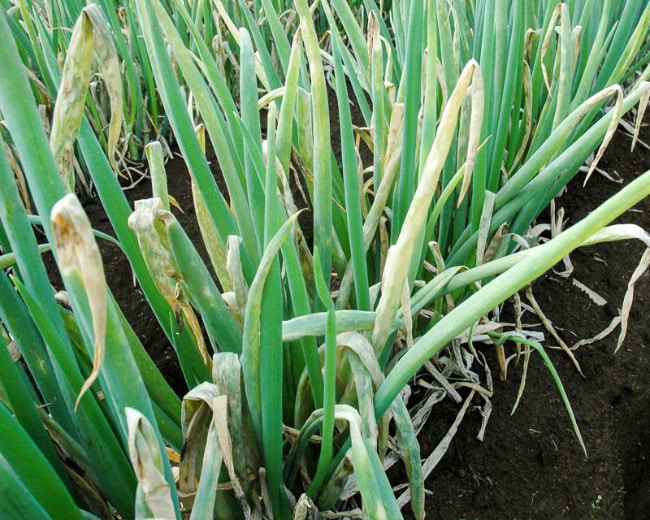
Onion rust
Another common disease that crops are susceptible to is onion rust. This disease occurs as a result of exposure to a fungus that spreads to the feathers of the plant. Over time, they are completely covered with a bloom of yellow and small fungal spores. If the bushes are not cured in a timely manner, the plant will stop development and the bulbs will stop ripening.
In order not to have to deal with the treatment of onion bulbs and their yellow feathers, it is necessary to properly care for the plant. The bushes are watered only at the root so that the liquid does not fall on the leaves. Also, the soil is periodically fed with mineral and organic fertilizers to strengthen the health of the vegetable.
Fusarium rot of the bottom
If the soil is not treated before planting a vegetable crop, then the onion will become infected with fusarium rot.This disease appears due to an infection that has penetrated into the root crop from the soil. Most often, infection occurs at the time of active growth of the onion.
The reasons for the appearance of infection include:
- too frequent moistening of the soil;
- late collection of fruits;
- harvesting in rainy weather;
- overheating of the soil due to dry weather.
When the disease manifests itself, measures must be taken immediately to stop the further development of the infection. To do this, diseased plants are immediately plucked and removed from the site. Then the damaged bulbs and beds are sprayed with Bordeaux liquid.
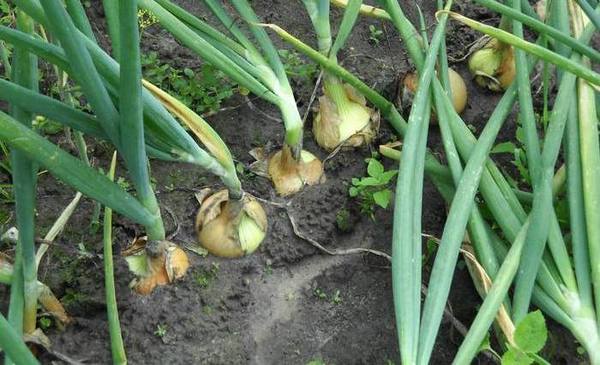
Neck rot of onions
With high humidity, onion bushes suffer from cervical rot, which affects the necks of the bulbs. The disease does not appear immediately, but only after harvesting from the site. Determining that a plant has this disease is quite simple. The scales and neck of the onion heads turn pink and become watery. Over time, the disease progresses, and the entire surface of the fruit is covered with gray mold. If the affected fruits are not treated with anything, they will be covered with a black, bumpy crust.
In order not to fight rot in the future, the onion disease is eliminated even in the garden. For this, the area is regularly treated with top dressing and cleared of weeds.
Wet bacterial rot and black rot
At the final stage of the growing season, the crop often suffers from viruses of black and wet bacterial rot. Due to these diseases, small dark wounds form on the feathers of the planted plants. Without timely treatment, the disease progresses and spreads to the fruits, completely destroying them. Affected bulbs rot and smell unpleasant.
The reasons for the development of rot include:
- improper loosening of the soil, due to which the bulb is damaged;
- sudden changes in weather and high humidity;
- damage to bushes by ticks or onion flies, which are carriers of the disease.
When the first signs of the disease appear, the affected plants must be removed immediately to stop the spread of rot.
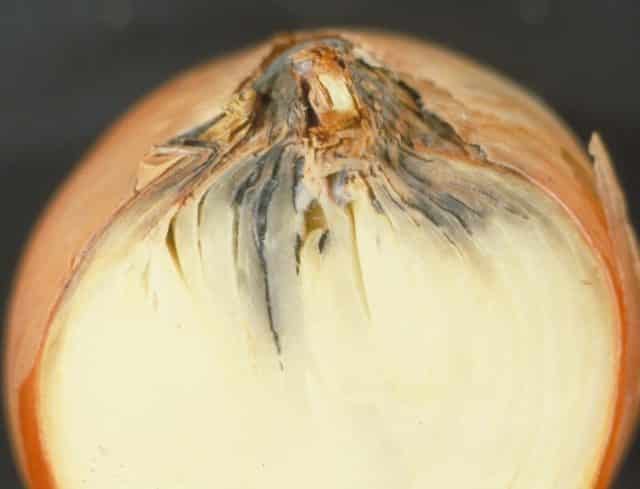
Onion mosaic
This disease affects the onion seedlings in the garden bed, which causes yellow spots to appear on the feathers of the plant. Infected bushes gradually lodge and grow more slowly.
In some cases, the disease affects the shape of the fruit. Infected bulbs elongate and become much thinner than healthy ones. They are also worse stored, as they quickly sprout and rot. Onions and other vegetables become infected with mosaics due to aphids, ticks and nematodes that carry the infection.
To protect plants from mosaics, only healthy seed should be planted. Also, for prevention, the upper part of the bulbs is periodically cut off.
Green mold rot
Vegetables in the garden often suffer from green mold rot that attacks the fruit. You can notice the manifestations of the disease on the bulbs of the affected plants. They wilt, watery brown or yellowish specks appear on them. Over time, the bulbs soften and develop an unpleasant moldy smell. Infected plants also suffer from leaves, which become covered with yellow spots and wither.
The development of the disease is activated after harvesting, since it is during storage that infected fruits quickly become stained and begin to rot.
Treatment methods
It is recommended to fight onion diseases in a timely manner in order to stop their further development. There are various methods of dealing with viral and infectious plant diseases. Often they use special means for processing vegetables for this.

It is recommended to use Fitoftherm, which is effective in the fight against infections and pests. Before using this preparation, a working solution is prepared.For its preparation, about 15 grams of the drug are added to ten liters of water. Before spraying the bushes, the soil should be thoroughly loosened so that the liquid is better absorbed by the soil. Vegetables should be processed with Fitofterm in the evening, in calm weather. When processing one bush, at least a liter of solution is consumed.
Some are engaged in the treatment of diseases of onions with folk remedies. For example, vegetable growers use tobacco infusion. To prepare it, 10–12 liters of warm water are mixed with 450 grams of tobacco. Before use, the mixture is infused for two days, after which it is boiled for an hour and a half. The bushes are sprayed with the prepared product three times weekly.
Prevention measures
Not only disease control should be carried out, but also prevention. This will significantly reduce the likelihood of disease occurrence in the vegetables grown on the site.
To reduce the risk of the appearance and development of diseases in onions, the following preventive measures are taken:
- the seed is treated prematurely so that it does not have pathogens on it;
- before planting, they disinfect and process the area on which vegetables will grow;
- observe crop rotation to protect plantings;
- do not use plant residues as compost.
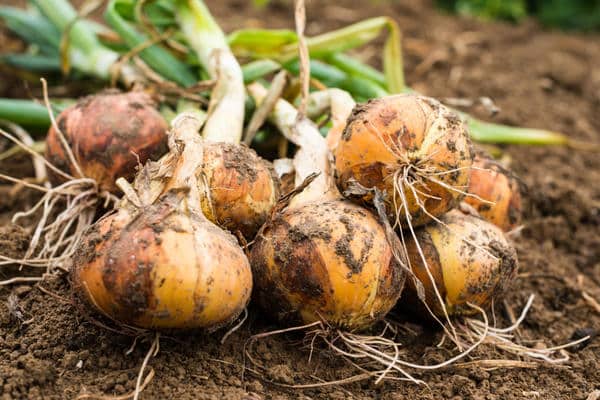
Conclusion
Often, vegetable growers who grow onions on their plots are faced with vegetable diseases. To cure and protect onion bushes, you should familiarize yourself in more detail with the features of common diseases and with methods of their treatment.
